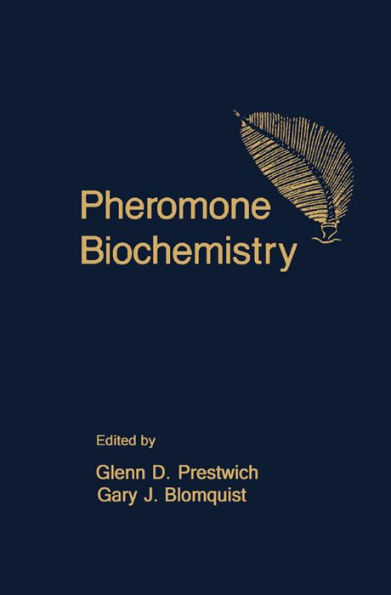5
1

Pheromone Biochemistry
586
by Glenn D. Prestwich (Editor), Gary J. Blomquist (Editor)
Glenn D. Prestwich

Pheromone Biochemistry
586
by Glenn D. Prestwich (Editor), Gary J. Blomquist (Editor)
Glenn D. Prestwich
eBook
$79.99
$93.95
Save 15%
Current price is $79.99, Original price is $93.95. You Save 15%.
Available on Compatible NOOK devices, the free NOOK App and in My Digital Library.
WANT A NOOK?
Explore Now
Related collections and offers
79.99
In Stock
Overview
Pheromone Biochemistry covers chapters on Lepidoptera, ticks, flies, beetles, and even vertebrate olfactory biochemistry. The book discusses pheromone production and its regulation in female insects; as well as reception, perception, and degradation of pheromones by male insects. The text then describes the pheromone biosynthesis and its regulation and the reception and catabolism of pheromones. Researchers in the areas of chemistry, biochemistry, entomology, neurobiology, molecular biology, enzymology, morphology, behavior, and ecology will find the book useful.

Product Details
| ISBN-13: | 9781483219370 |
|---|---|
| Publisher: | Elsevier Science |
| Publication date: | 06/28/2014 |
| Sold by: | Barnes & Noble |
| Format: | eBook |
| Pages: | 586 |
| File size: | 19 MB |
| Note: | This product may take a few minutes to download. |
About the Author
Dr. Gary Blomquist works at the Department of Biochemistry and Molecular Biology at the University of Nevada.
Table of Contents
PrefaceAcknowledgments
I. Pheromone Biosynthesis and its Regulation
1. Relationship of Structure and Function to Biochemistry in Insect Pheromone Systems
I. Introduction
II. Chemical Structure of Insect Pheromone Systems
III. Behavioral and Physiological Responses of Insects to Pheromones
IV. Biochemistry of Pheromone Systems
References
2. Biology and Ultrastructure of Sex Pheromone-Producing Glands
I. Introduction
II. Elucidation of Structural Details
III. Distribution of Glands
IV. Glands of Female Lepidoptera
V. Concluding Remarks
References
3. Pheromone Biosynthesis in Lepidopterans: Desaturation and Chain Shortening
I. Introduction
II. Methodology
References
4. Pheromone Biosynthesis: Enzymatic Studies in Lepidoptera
I. Introduction
II. Biosynthesis of Long Chain Acetate Ester, Alcohol, and Aldehyde Pheromones
III. Criteria for Identification of Enzymes in Pheromone Biosynthesis
IV. Pathway for Pheromone Biosynthesis in the Spruce Budworm Moth
V. Conclusions
References
5. Endocrine Regulation of Pheromone Production in Lepidoptera
I. Introduction
II. Previous Research Findings
III. Current Research
IV. Future Research
V. Prospects and Strategies for Exploiting Neurohormonal Regulation in Insects
References
6. Biosynthesis of Pheromones and Endocrine Regulation of Pheromone Production in Coleoptera
I. Introduction
II. Mechanisms of Production
III. Manipulation of Pheromone Chirality
IV. Endocrine Regulation of Pheromone Production
V. Concluding Remarks
References
7. Biosynthesis and Endocrine Regulation of Sex Pheromone Production in Diptera
I. Introduction: Dipteran Pheromones—An Overview
II. Reproductive Biology of the Housefly
III. Housefly Sex Pheromone
IV. Endocrine Regulation of Pheromone Production
V. Biosynthesis of Sex Pheromones in Diptera
VI. Summary
References
8. Alkaloid-Derived Pheromones and Sexual Selection in Lepidoptera
I. Introduction
II. Danaidone: First Characterization of a Hairpencil Secretion (Lycorea ceres)
III. Danaidone: Proven Pheromonal Function (Danaus gilippus)
IV. Pyrrolizidine Alkaloids: Proven Defensive Role (Utetheisa ornatrix)
V. Hydroxydanaidal: Pheromonal Indicator of Systemic Alkaloid Load (Utetheisa ornatrix)
VI. Pyrrolizidine Alkaloids: Parental Transmission to Egg (Utetheisa ornatrix and Danaus gilippus)
VII. Postscript
References
9. Neuroendocrine Regulation of Sex Pheromone-Mediated Behavior in Ixodid Ticks
I. Introduction
II. Sex Pheromones of Ixodid Ticks
III. Role of Ecdysteroids in Regulating Sex Pheromone Biosynthesis in Ticks and Insects
IV. Role of Juvenile Hormone/Gonadotropic Hormone in Regulating Tick Pheromone Activity
V. Metabolism of Ecdysones in Ticks
VI. Sites of Ecdysteroid Production in Ticks
VII. 20-Hydroxyecdysone as a Component of the Genital Sex Pheromone of Ixodid Ticks
VIII. Role of Neurosecretions in Stimulating Sex Pheromone Activity
IX. Perception of Pheromones
X. Summary
References
10. Cantharidin Biosynthesis and Function in Meloid Beetles
I. Introduction
II. Methodology
III. Results
IV. Topics for Investigation
References
II. Reception and Catabolism of Pheromones
11. Functional Morphology of Pheromone-Sensitive Sensilla
I. Introduction
II. Antennal Shape, Sensillar Form and Distribution—Uptake of Pheromone Molecules
III. Fine Structure of Olfactory Hairs—Stimulus Transport to the Receptor Site
IV. Cellular Organization—Implications for Electrophysiology and Biochemistry
V. Supplementary and Concluding Remarks
References
12. The Molecular Basis of Pheromone Reception: Its Influence on Behavior
I. Introduction
II. The Animal
III. Sensory Hair Proteins
IV. Dynamic Interactions between Pheromone and Sensory Hair Proteins: Models of Pheromone Reception
V. Transductory Mechanisms
VI. Species Comparisons: The Biochemistry of Pheromone Reception in the Gypsy Moth
VII. Variation in Olfactory Proteins: Evolvable Elements Encoding Insect Behavior
VIII. The Future: The Molecular Basis of Pheromone Reception, the Molecular Basis of Behavior
References
13. The Neurobiology of Pheromone Reception
I. General Introduction
II. Types of Neurophysiological Research and Methods
III. Interpretation of Responses to Pheromone
IV. What Do Single Sensillum Responses Tell Us about Primary Chemoreceptor Processes
V. Interpretation of Electroantennograms
The Electrical Equivalent Network of Antennae
References
14. Chemical Studies of Pheromone Reception and Catabolism
I. Introduction
II. Methodology
III. Specific Examples
IV. Conclusion
References
15. Molecular Mechanisms of Vertebrate Olfaction: Implications for Pheromone Biochemistry
I. Introduction
II. Olfactory Membrane Preparations
III. Transductory Enzymes and Second Messengers
IV. Ion Channels and Their Modulation
V. Olfactory Receptor Proteins: Problems and Prospects
References
Index
From the B&N Reads Blog
Page 1 of
